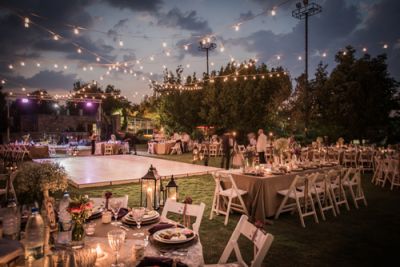 What’s not to love about an outdoor wedding? You could get married in a majestic location, enjoy fabulous weather, and incorporate natural scenery into your event’s theme and décor. On the other hand, it can also bring several unique challenges to your planning. Stay prepared for these issues by following some wise advice.
What’s not to love about an outdoor wedding? You could get married in a majestic location, enjoy fabulous weather, and incorporate natural scenery into your event’s theme and décor. On the other hand, it can also bring several unique challenges to your planning. Stay prepared for these issues by following some wise advice.
Select Your Date and Time Carefully
A summer outdoor wedding can be incredibly romantic, but not if the mercury soars upward and your guests are suffering in the heat. Conversely, winter weddings held outside come with the risk of excessively cold temperatures, snow, and ice. Late spring or fall may be more ideal, depending on where you live. Those whose hearts are set on summer nuptials should keep in mind that temperatures are typically lower in the early morning or late evening. If you’re saying “I do” during any time of year with warm weather, make sure you provide chilled bottles of water for your guests during the ceremony.
Always Have a Backup Plan
Keeping your eyes on the skies is one thing, but you’ll definitely want to formulate a Plan B just in case the weather doesn’t cooperate. The Spruce writer Nina Callaway recommends selecting a ceremony or reception site that has both indoor and outdoor facilities. Alternatively, you can hold the ceremony outside and the reception inside, since the former should only run between 20 and 30 minutes long. If you do choose a tent, chuppah, or canopy for your affair, be sure to select a model that’s sturdy, can fend off moderate amounts of rain, and won’t easily blow away in the wind.
Important Amenities to Consider
Many essentials that you’d take for granted when planning an indoor event become critical when you take your celebration outside. Chances are, your outdoor site may not include key facilities such as:
- Restrooms
- Tables and chairs
- Shade and climate control
- Sound equipment
- Lighting
- Food storage and refrigeration
- Clearly marked areas for foot traffic
- A dance floor
- Electricity
When you’re evaluating each location, it’s wise to go through this checklist and verify the available amenities at each site. Also, you must factor these costs into your wedding budget. Providing these essentials can quickly add up, possibly making an outside site far more expensive than an indoor venue. Follow best practices such as reading customer reviews, speaking with references, and reading any fine print while shopping for your vendors.
Finally, don’t forget to plan for pest control. Bridal Guide contributor Augusta Cole suggests having a professional company apply one around the site. You can also incorporate citronella torches and include natural bug-fighting botanicals such as lavender, mint, or thyme.
Tips for Food and Drink Safety
Whether you’re hiring a caterer or going the potluck route, you can’t forget about food safety practices for outside events. Martha Stewart Weddings advises steering clear of rich and heavy dishes and serving cheeses during the cooler hours of the day. Brides contributor Whitney C. Harris recommends adding cool and refreshing foods to your menu. Also, keep in mind that seafood can go bad quickly and frozen desserts will melt more rapidly in the heat. Dairy-based dishes and desserts are especially tricky to manage in hot weather, since they’re in greater danger of spoiling. That also goes for your wedding cake, especially if it’s covered in buttercream frosting or contains marzipan, ganache, or mousse.
An outdoor wedding can offer plenty of pluses, but only if you follow some smart planning steps. To ensure that everyone is comfortable, pay attention to key factors such as your event date and time, provide important amenities, and follow food and drink safety practices. With these useful hints, your nuptials will be an unforgettable experience for you and your guests.
Add Your Comment